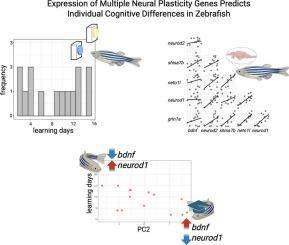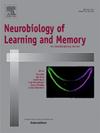Analysis of neural plasticity genes’ expression in fish brain reveals the basis of individual differences in learning
IF 1.8
4区 心理学
Q3 BEHAVIORAL SCIENCES
引用次数: 0
Abstract
Individual differences in cognition have been historically recognized in humans, and recent evidence suggests that such variation is widespread across the animal kingdom. Despite its importance for individuals’ behaviour and fitness, the biological roots of cognitive variation remain poorly understood. We hypothesize that variation in brain gene expression is important in determining individual cognitive differences. To test this, we focused on 6 neural plasticity genes and examined fish, which exhibit the largest cognitive variation reported for vertebrates. Zebrafish (Danio rerio) exposed to visual discrimination tasks showed substantial variation in their performance, with some learning over 7 times faster than others. Expression of two genes positively predicted learning performance. However, expression levels of most genes were related at the individual level, suggesting that multi-gene expression patterns may be more relevant than single gene variation. Principal component analysis identified two axes of multi-gene expression variation: the first loaded by all genes except neurotrophin bdnf, the second mainly loaded by bdnf and neurod1 expression. Only the latter component significantly predicted learning performance in a visual discrimination task, indicating that individual variation in bdnf expression and with lesser extend neurod1 are critical for learning. Our study bridges the gap between cognitive differences and molecular mechanisms underlying brain function, providing foundation for new understanding what makes individual unique.

对鱼脑神经可塑性基因表达的分析揭示了个体学习差异的基础。
人类认知的个体差异在历史上已经被认识到,最近的证据表明,这种差异在动物王国中很普遍。尽管认知变异对个体的行为和适应性很重要,但它的生物学根源仍然知之甚少。我们假设大脑基因表达的变异在决定个体认知差异方面是重要的。为了验证这一点,我们集中研究了6种神经可塑性基因,并研究了鱼类,它们在脊椎动物中表现出最大的认知变异。斑马鱼(Danio rerio)在视觉识别任务中表现出很大的差异,一些斑马鱼的学习速度比其他斑马鱼快7倍以上。两个基因的表达正预测学习成绩。然而,大多数基因的表达水平在个体水平上是相关的,这表明多基因表达模式可能比单基因变异更相关。主成分分析确定了多基因表达变异的两个轴:第一个轴由除神经营养因子bdnf外的所有基因负载,第二个轴主要由bdnf和neurod1表达负载。只有后者能显著预测视觉辨别任务中的学习表现,这表明bdnf表达的个体差异和较小的延伸神经d1对学习至关重要。我们的研究弥合了认知差异和脑功能分子机制之间的差距,为新的理解个体独特性提供了基础。
本文章由计算机程序翻译,如有差异,请以英文原文为准。
求助全文
约1分钟内获得全文
求助全文
来源期刊
CiteScore
5.10
自引率
7.40%
发文量
77
审稿时长
12.6 weeks
期刊介绍:
Neurobiology of Learning and Memory publishes articles examining the neurobiological mechanisms underlying learning and memory at all levels of analysis ranging from molecular biology to synaptic and neural plasticity and behavior. We are especially interested in manuscripts that examine the neural circuits and molecular mechanisms underlying learning, memory and plasticity in both experimental animals and human subjects.

 求助内容:
求助内容: 应助结果提醒方式:
应助结果提醒方式:


